The Economics and Statistics Division maintains archives of previous publications for accountability purposes, but makes no updates to keep these documents current with the latest data revisions from Statistics Canada. As a result, information in older documents may not be accurate. Please exercise caution when referring to older documents. For the latest information and historical data, please contact the individual listed to the right.
<--- Return to Archive
For additional information relating to this article, please contact:
February 07, 2025LABOUR MARKET TRENDS, JANUARY 2025 January labour force survey results reflect the period from January 12 to 18, 2025.
Ages 15+ (January 2025 vs December 2024, seasonally adjusted)
Nova Scotia's seasonally adjusted employment declined by 500 (-0.1%) to 527,200 in January following a rise of 6,000 (+1.2%) in the previous month.
The change in employment was attributable to a decline in full-time employment (-3,800) that offset the rise in part-time employment (+3,300). Note that changes in full-time and part-time employment can also reflect changing hours for the same job.
Nova Scotia’s labour force declined by 2,700 (-0.5%) to 560,400 in January 2025.
With labour force declining at a faster pace than employment, Nova Scotia's unemployment rate declined 0.4 percentage points to 5.9% in January 2025.
Nova Scotia's labour force participation rate declined 0.3 percentage points to 61.6% and the employment rate was unchanged at 58.0% in January 2025.
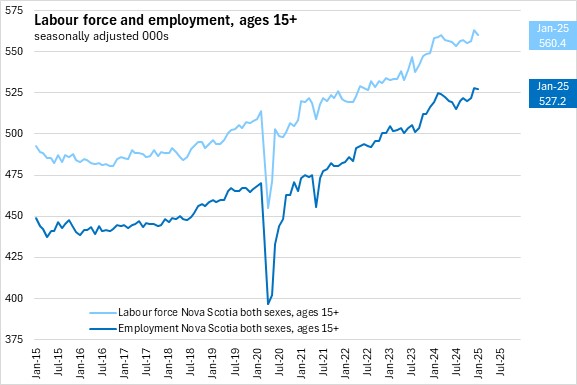
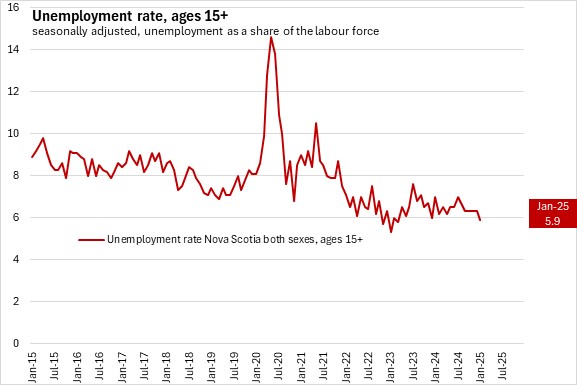
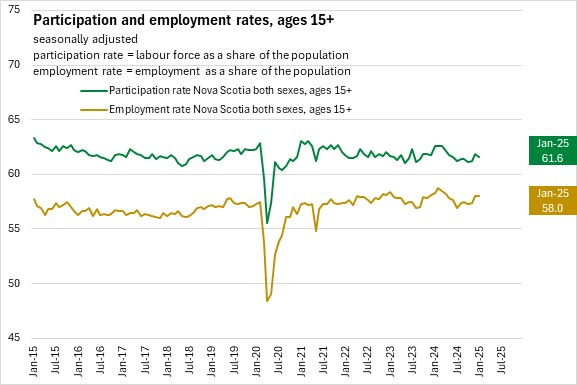

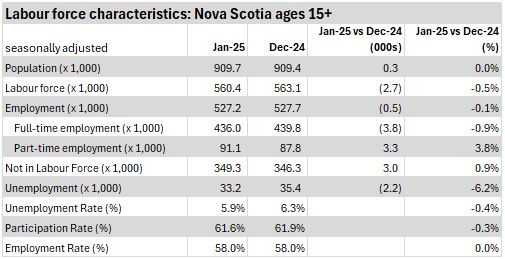
Ages 15+ (January 2025 vs January 2024, seasonally adjusted)
Compared with January 2024, Nova Scotia's population over the age of 15 increased by 18,500 (+2.1%), while the labour force grew by 2,100 (+0.4%), and employment increased by 7,800 (+1.5%). The unemployment rate declined by 1.1 percentage points while the participation rate fell by 1.0 percentage point and the employment rate fell by 0.3 percentage points.
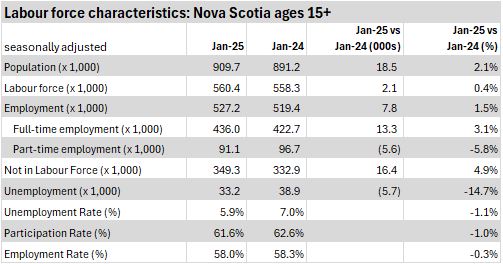
Age Cohorts (January 2025 vs December 2024, seasonally adjusted)
Among youth (ages 15-24), employment was down 1,000 (-1.4%) while the labour force rose by 1,600 (+2.1%). With a larger labour force and shrinking employment, the youth unemployment rate rose 3.1 percentage points to 13.0% in January. The youth participation rate rose 1.5 percentage points to 67.0% while the youth employment rate was down 0.7 percentage points to 58.3%.
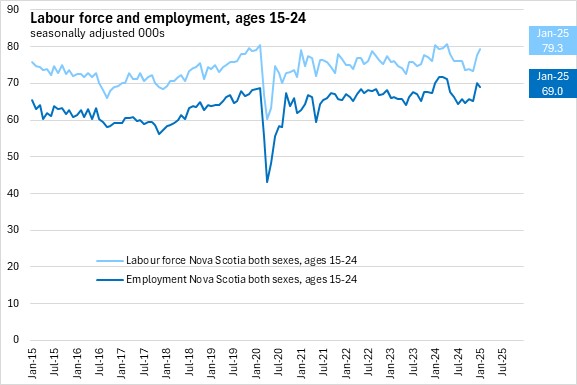
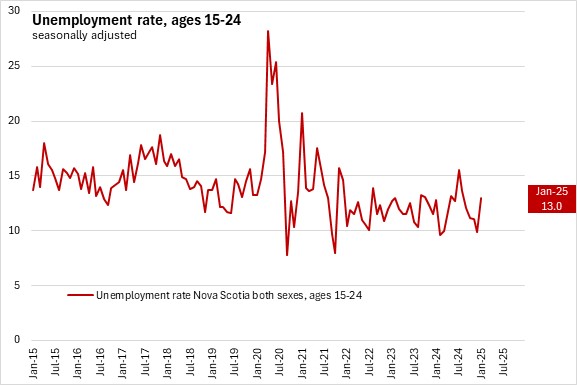
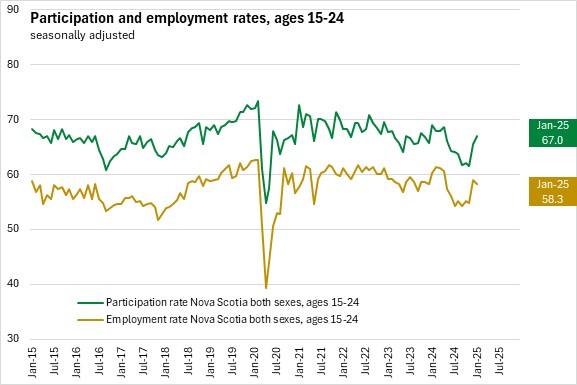
The population aged 25-54 makes up the largest part of the labour force. In the core age group, employment was down 1,400 (-0.4%) while the labour force fell by 2,300 (-0.6%). With employment falling slower than the labour force, the core aged unemployment rate declined 0.2 percentage points to 5.0% in January 2025. The core aged participation rate declined 0.7 percentage points to 87.0% and the core aged employment rate was down 0.5 percentage points to 82.7%.
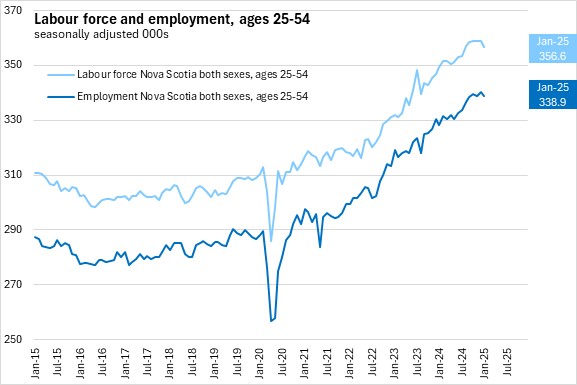
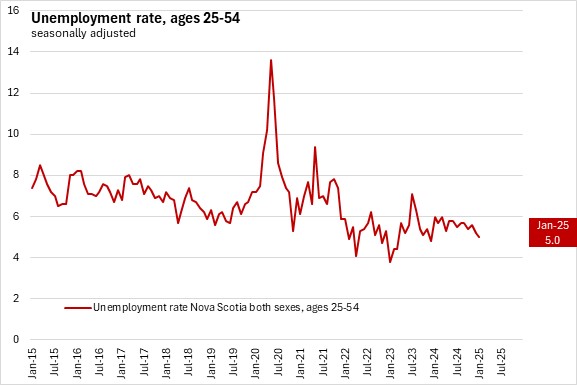
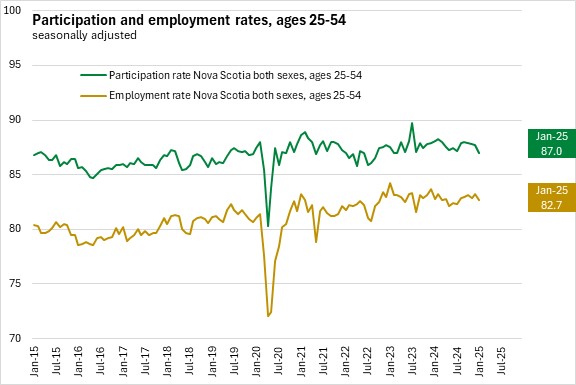
Older workers (aged 55+) reported that employment increased by 2,100 (+1.8%) while the labour force fell by 2,000 (-1.6%). With higher employment and a smaller labour force, the older worker unemployment rate declined 3.1 percentage points to 4.1%. The older worker participation rate fell 0.6 percentage points to 32.6% and the employment rate for older workers rose 0.6 percentage points to 31.3%.
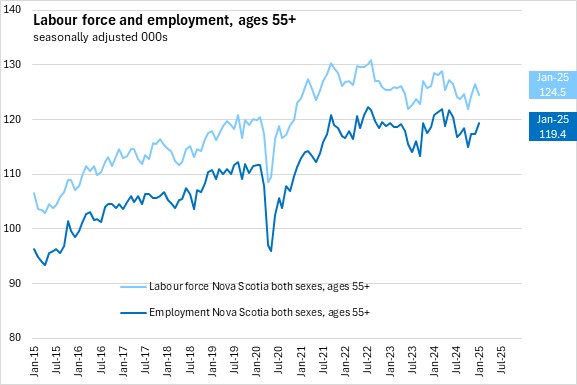
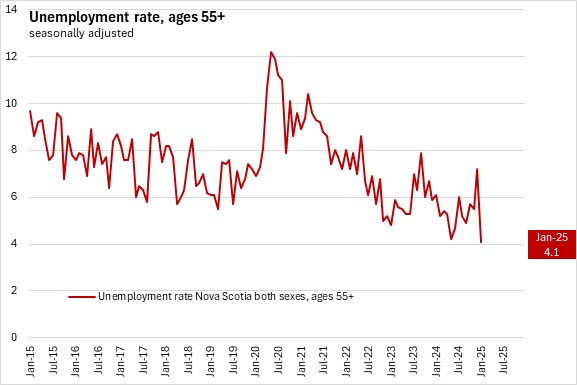
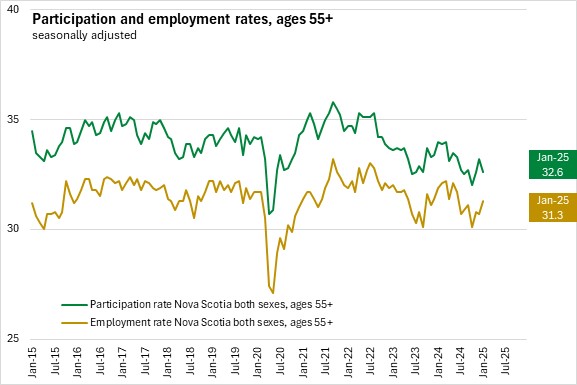
Males and Females (Ages 15+, January 2025 vs December 2024, seasonally adjusted)
Monthly employment increased by 200 (+0.1%) for males while the labour force declined by 2,400 (-0.8%) from December. With employment falling and labour force rising, the male unemployment rate declined 0.8 percentage points to 6.6% in January. The male participation rate declined by 0.6 percentage points to 64.7% and the employment rate was unchanged at 60.5%.

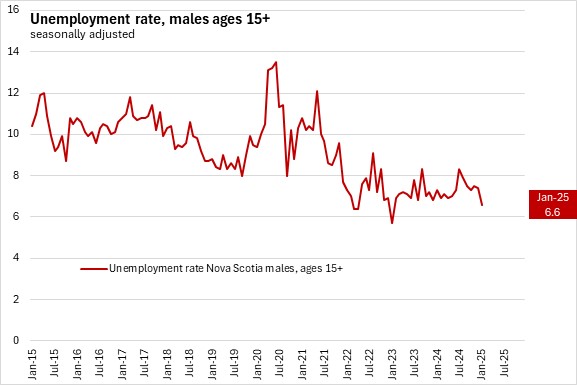
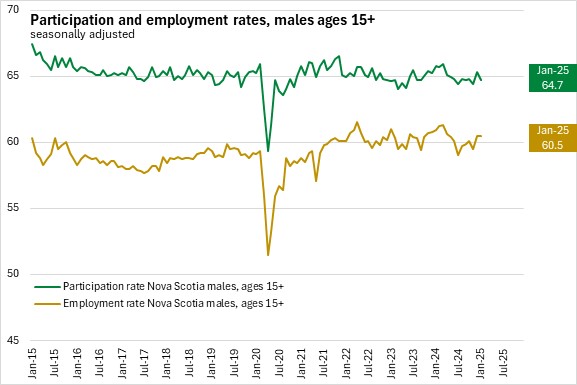
Females reported an employment decline 700 (-0.3%) and a labour force decline of 100 (-0.04%). With employment falling faster than labour force, the female unemployment rate rose to 5.3% in January. The female participation rate was unchanged at 58.6% and the female employment rate fell by 0.2 percentage points to 55.5%.
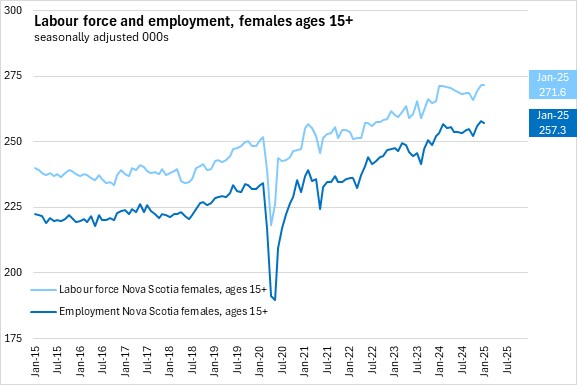
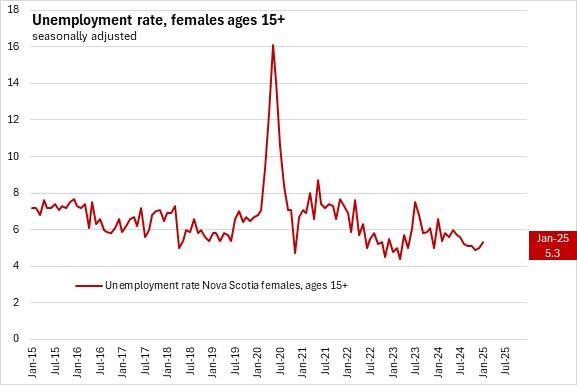
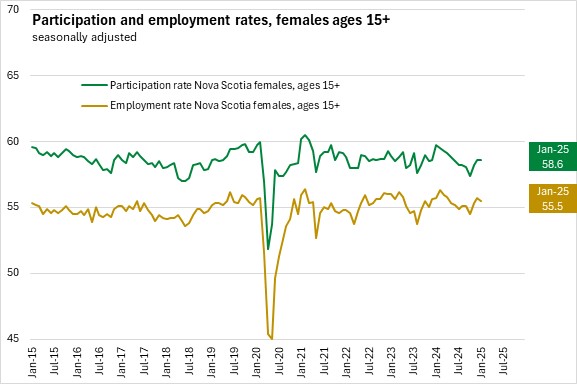
January's rise in employment was due to lower employment among youth and core-aged workers, and females. Labour force decline was concentratred among workers aged 25 and over (including older workers) and males, which translated into more persons not in the labour force for these groups. There was a large decline in unemployment for those aged 55 and over, as well as males, while youth and females reported higher unemployment compared to December.
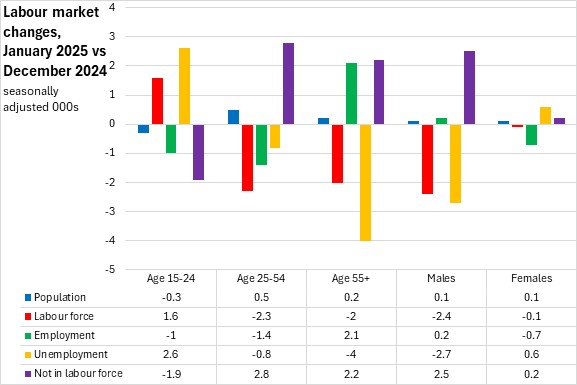
Age and sex cohorts (January 2025 vs January 2024, seasonally adjusted)
Compared with January 2024, employment growth was strongest among core-aged workers (whose population has also grown the most over this period). Youth and older workers has similar employment declines compared to one year ago. All age cohorts and both sexes reported lower unemployment compared to one year ago (youth unemployment was unchanged).
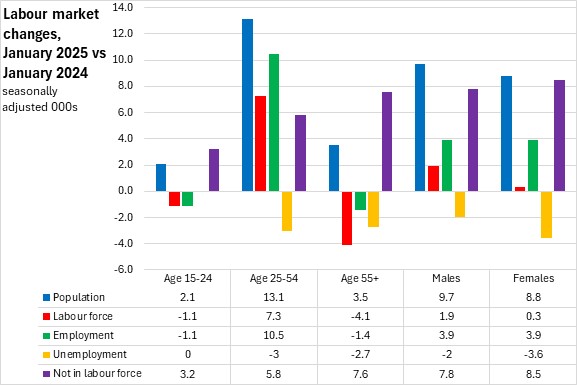
Class of Worker and Industry (January 2025 vs December 2024, seasonally adjusted)
The January 2025 employment change was due to declines for private sector (-500, -0.2%) and among the self-employed (-300, -0.6%) workers. Public sector employment rose by 400 (+0.3%) in January.
Classified by industry, the largest employment gains from December to January were in wholesale/retail and transportation/warehousing. The fastest declines were in information/culture/recreation and construction.
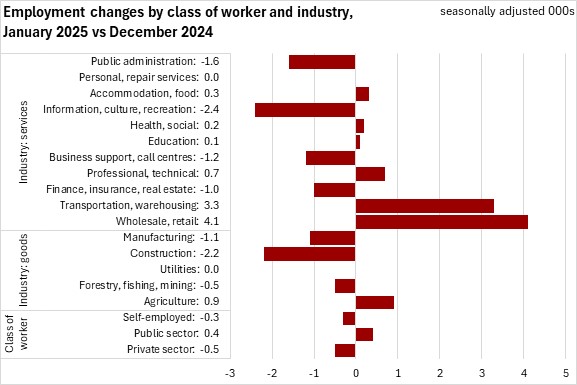
Class of Worker and Industry (January 2025 vs January 2024, seasonally adjusted)
Compared to January 2024, there were employment gains for public sector workers (+10,700 or +8.2%), with declines for private sector workers (-2,000 or -0.6%) and self-employed (-700 or -1.3%).
Over the last 12 months, employment was up the most for accommodation/food services and health/social assistance, followed by construction, transportation/warehousing and public administration. The largest declines were in personal/repair services, finance/insurance/real estate and wholesale/retail.
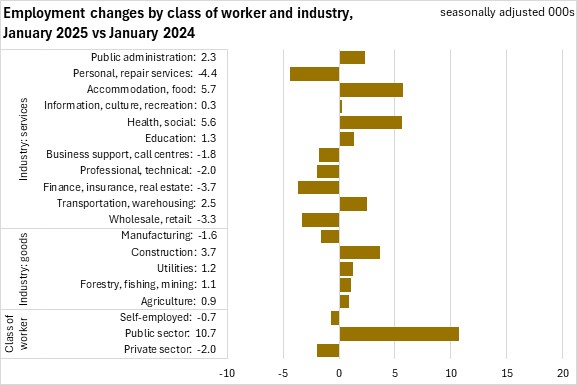
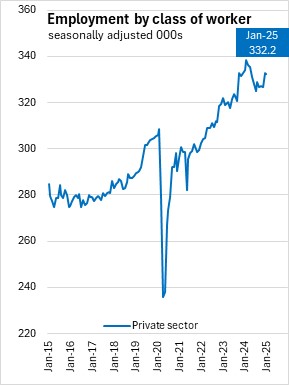
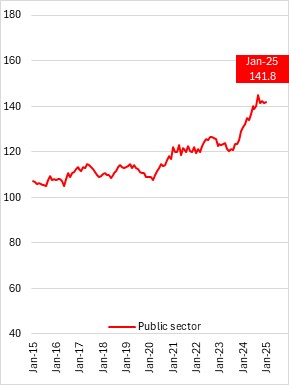
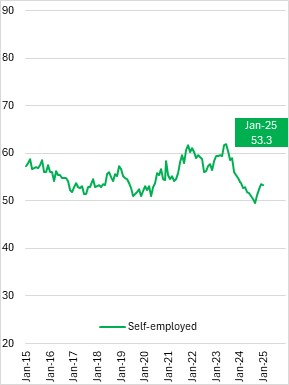
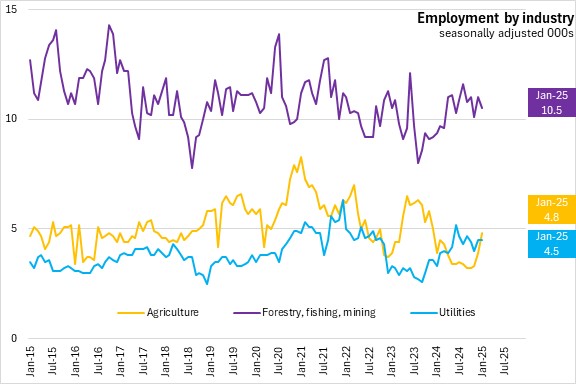
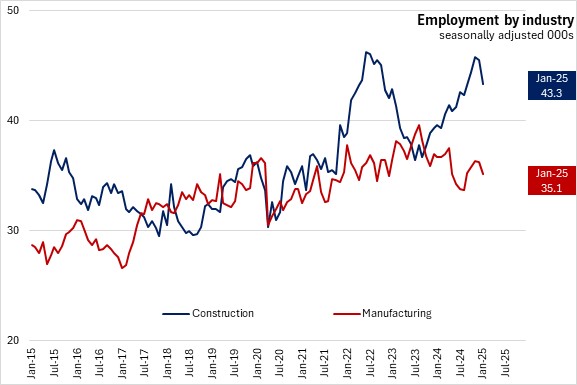
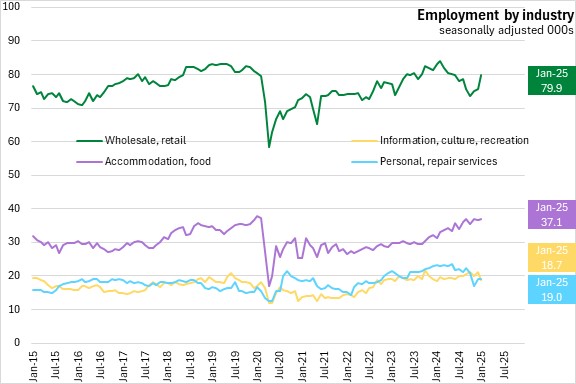
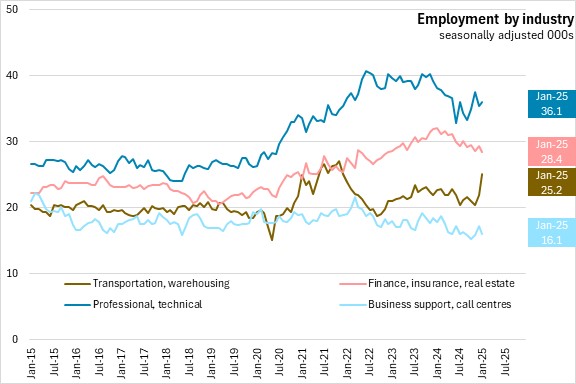

Hours worked and employment (January 2025, unadjusted)
Compared to the provincial average, a larger share of workers in goods producing industries, as well as transportation/warehousing and health care/social assistance, worked more than 40 hours per week in January 2025.

Note that some data on those working few hours in business support (including call centres), utilities, forestry/fishing/mining and agriculture were suppressed.
Average weekly earnings (unadjusted, both full time and part time, January 2025 vs January 2024)
Average weekly earnings increased by 7.2% from January 2024 to January 2025. The fastest gains in average weekly earnings were in accommodation/food services and health care/social assistance. The largest declines in average weekly wages were in agriculture, followed by personal/repair services.
The increase in Nova Scotia's all items consumer price index was 0.9% from December 2023 to December 2024.
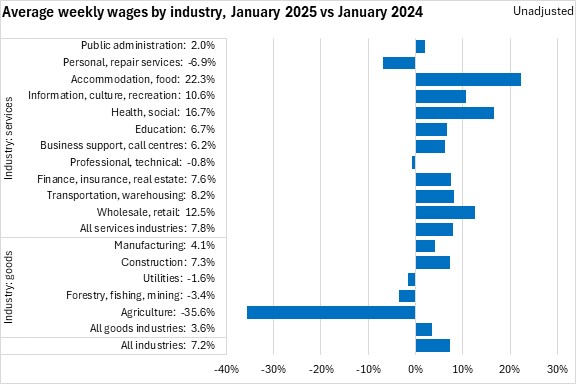
Average weekly earnings across all employees were $1,165.41 in January 2025. The highest average weekly earnings (both full and part time employees) were reported in utilities, professional/technical services, and public administration. The lowest average weekly earnings were in agriculture and accommodation/food services.

Regions (January 2025 vs January 2024, unadjusted 3 month moving average)
Compared with January 2024, labour force and employment increases were highest in Cape Breton, followed by North Shore. Cape Breton reported faster growth in employment than labour force, resulting in lower unemployment compared to one year ago. The North Shore labour force growth that outpaced employment growth, resulting in higher unemployment. Both regions reported declines in the number of persons not in the labour force. Annapolis Valley reported lower labour force and employment compared to one year ago, largely resulting in more persons not in the labour force. Southern Nova Scotia reported a small decline in the labour force, more persons not in the labour force, and no change in employment compared to January 2024. Halifax reported the strongest population growth, with employment growth outpacing labour force growth, and a large increase in the number of persons not in the labour force.
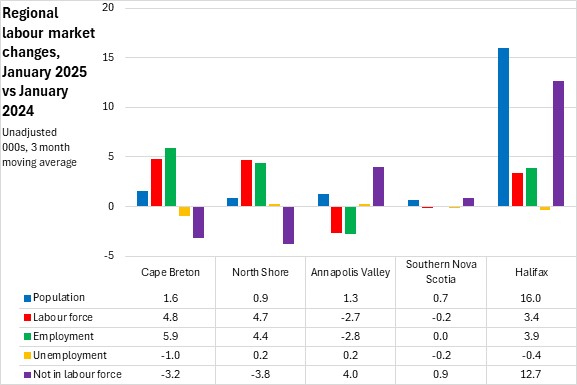
Unemployment rates were down in every region except Annapolis Valley compared to one year ago.
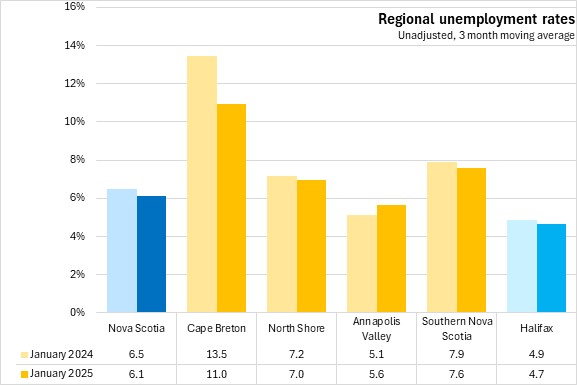
Participation and employment rates rose in Cape Breton and North Shore, and declined in Annapolis Valley, Southern Nova Scotia and Halifax.

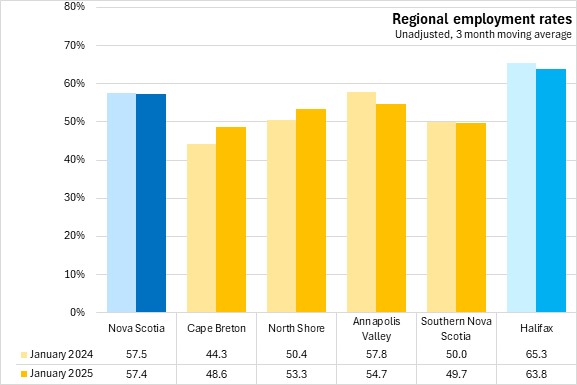
Provincial Comparisons (seasonally adjusted)
Canada's labour force rose 0.3% from December with five provinces reporting growth in January 2025. British Columbia reported the fastest growth while the largest declines were in Prince Edward Island and Saskatchewan.
Compared with January 2024, the national labour force was up 3.1% with all provinces except Newfoundland and Labrador reporting growth. Ontario and Alberta reported the fastest increase compared to one year ago.
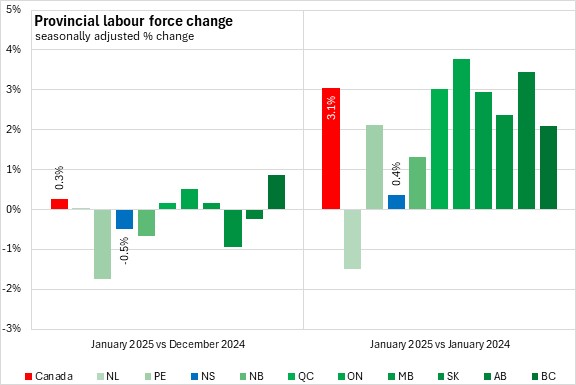
Canada's employment was up 0.4% from December to January. Five provinces reported higher employment in January, led by British Columbia. Compared with January 2024, the national gain was 2.0% with the fastest growth in Alberta and the only decline in Newfoundland and Labrador.
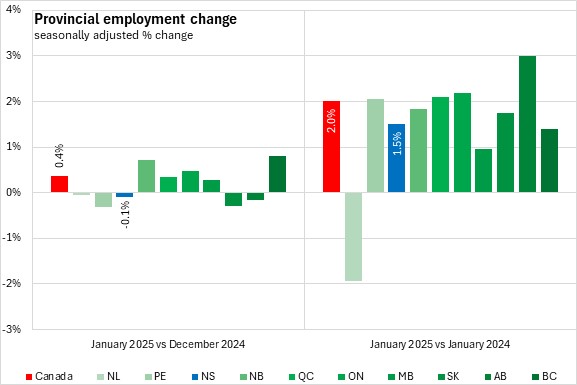
The national unemployment rate was 6.6% in January 2025, up from 5.7% in January 2024. Saskatchewan and Quebec had the lowest unemployment rate while Newfoundland and Labrador reported the highest unemployment rate in January 2025.
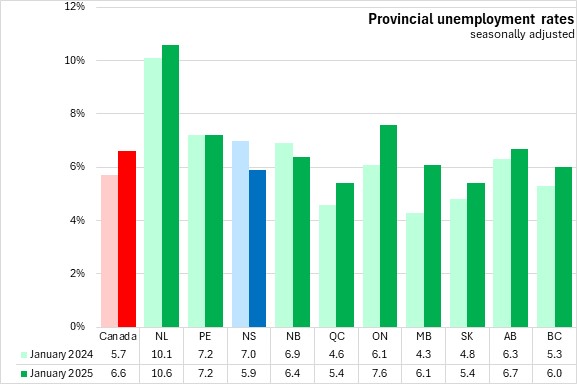
The national participation rate was 65.5% in January 2025. The highest participation rate was in Alberta while the lowest was in Newfoundland and Labrador.
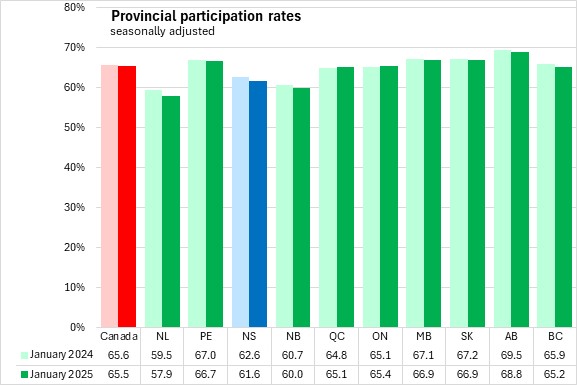
The national employment rate was 61.1% in January 2025. Alberta reported the highest employment rate while Newfoundland and Labrador reported the lowest.
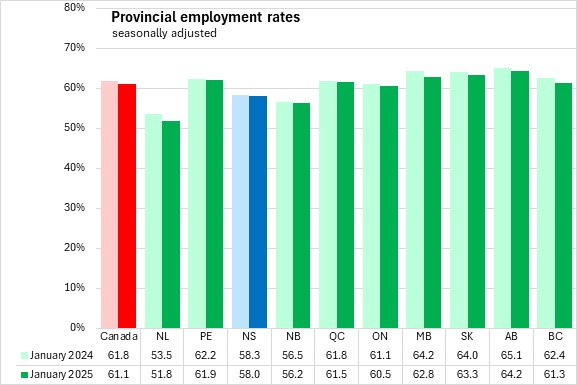
Census Metropolitan Areas (January 2025, seasonally adjusted 3 month moving average)
The Halifax & East Hants unemployment rate was 5.0% in the seasonally adjusted January 2025 three month moving average. Outside of Halifax the unemployment rate was 7.6%. In central and western provinces, unemployment rates in Census Metropolitan Areas are similar to or higher than unemployment rates outside CMAs. In the Atlantic Provinces unemployment rates are typically higher outside CMAs.
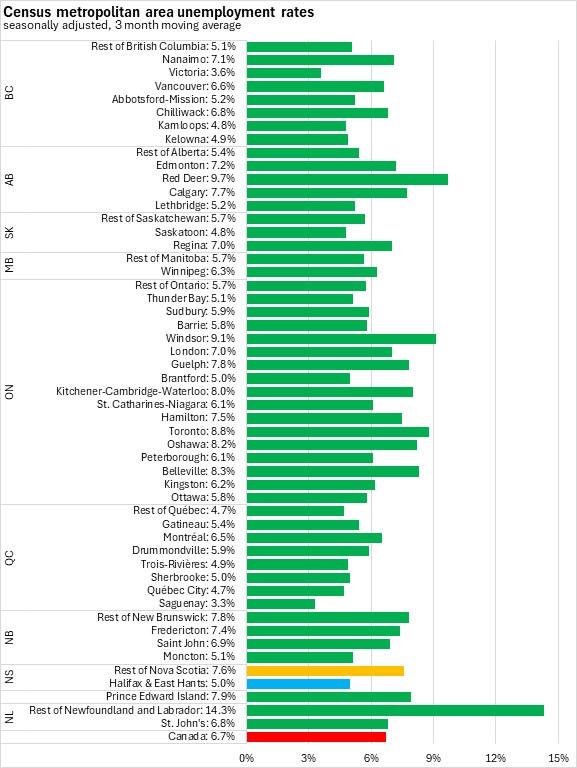
Halifax and East Hants' participation rate was 67.8% in the seasonally adjusted January 2025 three month moving average, while participation rates were 55.5% across the rest of the province.
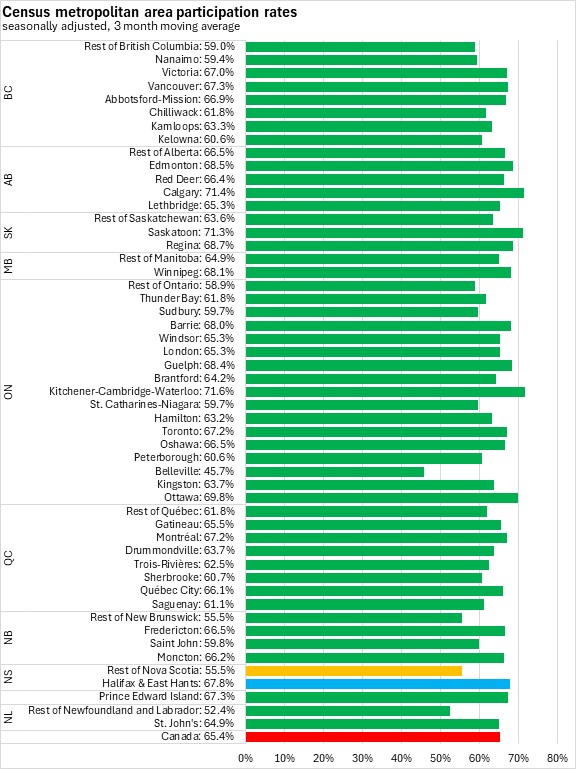
Halifax CMA reported an employment rate of 64.4% in the seasonally adjusted January 2025 three month moving average, while the employment rate was 51.3% outside the city.
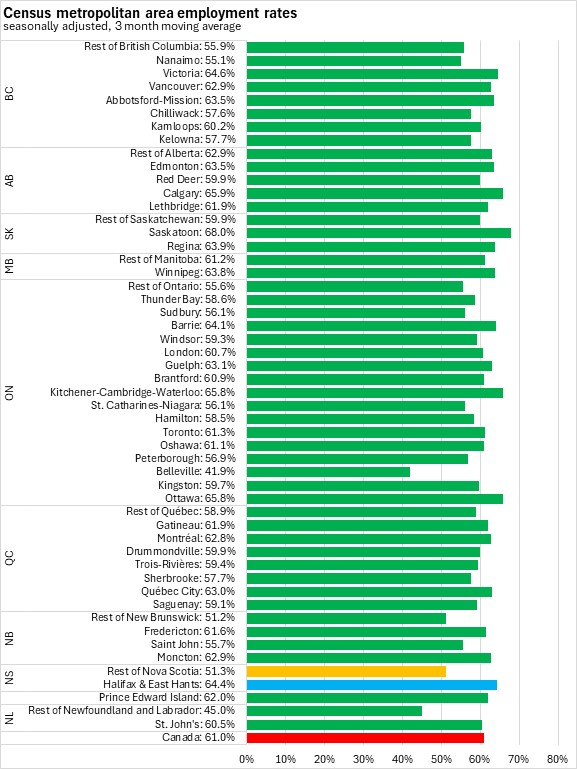
Sources: Statistics Canada. Table 14-10-0036-01 Actual hours worked by industry, monthly, unadjusted for seasonality; Table 14-10-0063-01 Employee wages by industry, monthly, unadjusted for seasonality; Table 14-10-0287-01 Labour force characteristics, monthly, seasonally adjusted and trend-cycle, last 5 months; Table 14-10-0288-01 Employment by class of worker, monthly, seasonally adjusted and unadjusted, last 5 months (x 1,000); Table 14-10-0355-01 Employment by industry, monthly, seasonally adjusted and unadjusted, and trend-cycle, last 5 months (x 1,000); Table 14-10-0459-01 Labour force characteristics by census metropolitan area, three-month moving average, seasonally adjusted; Table 14-10-0462-01 Labour force characteristics by economic region, three-month moving average, unadjusted for seasonality
<--- Return to Archive